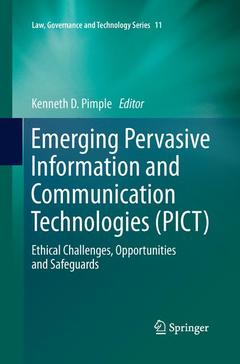Emerging Pervasive Information and Communication Technologies (PICT), 2014 Ethical Challenges, Opportunities and Safeguards Law, Governance and Technology Series, Vol. 11

This book provides a wide and deep perspective on the ethical issues raised by pervasive information and communication technology (PICT) ? small, powerful, and often inexpensive Internet-connected computing devices and systems. It describes complex and unfamiliar technologies and their implications, including the transformative potential of augmented reality, the power of location-linked information, and the uses of ?big data,? and explains potential threats, including privacy invaded, security violated, and independence compromised, often through widespread and lucrative manipulation.
PICT is changing how we live, providing entertainment, useful tools, and life-saving systems. But the very smartphones that connect us to each other and to unlimited knowledge also provide a stream of data to systems that can be used for targeted advertising or police surveillance. Paradoxically, PICT expands our personal horizons while weaving a web that may ensnare whole communities.
Chapters describe particular cases of PICT gone wrong, but also highlight its general utility. Every chapter includes ethical analysis and guidance, both specific and general. Topics are as focused as the Stuxnet worm and as broad as the innumerable ways new technologies are transforming medical care.
Written for a broad audience and suitable for classes in emerging technologies, the book is an example of anticipatory ethics ? ?ethical analysis aimed at influencing the development of new technologies? (Deborah Johnson 2010).
The growth of PICT is outpacing the development of regulations and laws to protect individuals, organizations, and nations from unintended harm and malicious havoc. This book alerts users to some of the hazards of PICT; encourages designers, developers, and merchants of PICT to take seriously their ethical responsibilities ? if only to ?do no harm? ? beforetheir products go public; and introduces citizens and policy makers to challenges and opportunities that must not be ignored.
Date de parution : 08-2015
Ouvrage de 252 p.
15.5x23.5 cm
Date de parution : 09-2013
Ouvrage de 252 p.
15.5x23.5 cm
Thème d’Emerging Pervasive Information and Communication... :
Mots-clés :
Ambient Intelligence; Automated Systems in the Financial Markets; Autonomous Algorithms with the Demands of Stock Markets; Autonomous Drones Deployed in Central Asia; Challenge to Government Control of Public Space; Computer Virus Engineered to Disrupt; Destroying Privacy; Domestic Surveillance; Emerging Technologies; Empirical Examination of Longitudinal Data; Era of Pervasive Computing; Ethical Implications of Ambient Intelligence Environments; Foregrounding Ethics During Technology Design; Governance; Involuntary Disclosure of Private Information; Moral Responsibility for Computing Artifacts; Pervasive Computing; Pervasive Information and Communication Technologies (PICT); Practical Ethics; Public Policy Governance; Public Surveillance; PublicHealth Surveillance; Rogue or Mis-Configured Autonomous System; Surveillance; Privacy and Technology; The Stuxnet Worm; Ubiquitous Computing; Virtual Environment Inside the Computer; Volatile Financial System
